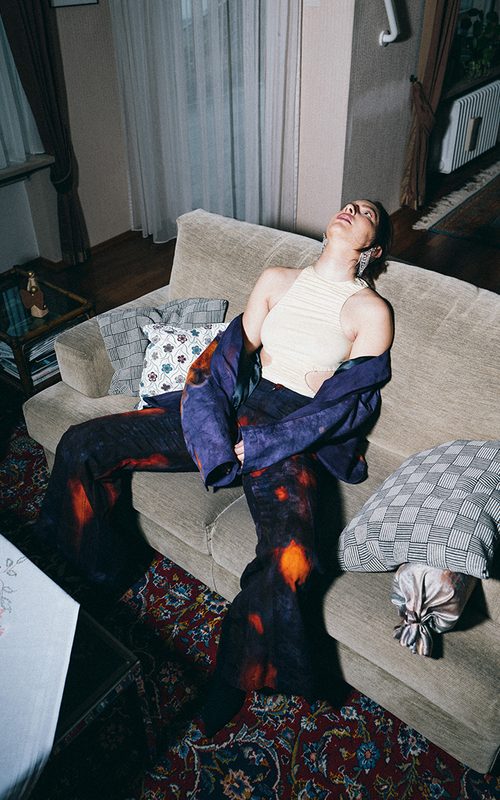

My collection ‚Can we still dream?‘ is asking how much escapism one can allow in order to live a happy life and how much dystopia one has to be confronted with in order to change the world through positive activism. What’s the balance between actively engaging with negative news and having the desire to escape reality?
To address that inner conflict, a virtual google maps journey is being made. Modern technology makes it possible to easily self-discover very different places on earth. Do we choose to only dream about exotic islands or do we also look at dystopian places that might just be known from negative? The beautiful island Kerguelen and stunning nature in the Alpes are contrasted by the melting ice at the antarctic. Also giant artificial farming fields in Alméria, Spain that can even be seen from space are frightening to see.
Those places are inspiration for comfortable bodysuits with circular shaped cutouts and gatherings. A print is developed by a scenery in nature and also picks up fluid forms. It is transferred on Lycra fabric that is made out of recycled ocean plastic. The structure of the melting ice is recreated through a natural dyeing technique with logwood and lemon.
Being unable to cope with reality, escapism is an understandable form of dealing with negative feelings. In this work, the utopia of an idyllic family life is further highlighted. Being at home can be seen as a sanctuary that protects from the chaotic outside world. A personal family picture that was taken on new years eve in the 80ies stands for ultimate escapism. It is inspiration for tailoring elements that refer towards garments that are usually worn at festive occasions. The colourboard as well as working with upcycled tablecloth are inspired by this photograph.
Working as sustainable as possible without using any new resources has high priority. Therefore upcycled tablecloth and deadstock are being used, as well as lycra that consists of Econyl - a fiber made from recycled ocean plastic. Natural dyeing methods with logwood, lemon and barberry create interesting sustainable surfaces. The most important part of this collections is self-developed bioplastic that is mainly made out of tapioca starch. It is organic, recyclable and can be mold into new shapes through reheating it. The material is very flexible and is slightly transparent.
The aim for the future is to develop a technique that makes bioplastic water resistible. Finding a way that bioplastic garments can be worn on a daily basis will hopefully help changing the fashion industry.
This encourages the participants towards taking more social and environmental responsibility. It’s important to question oneself in which parts improvement can be made, so that we all actively help creating a better future.
To address that inner conflict, a virtual google maps journey is being made. Modern technology makes it possible to easily self-discover very different places on earth. Do we choose to only dream about exotic islands or do we also look at dystopian places that might just be known from negative? The beautiful island Kerguelen and stunning nature in the Alpes are contrasted by the melting ice at the antarctic. Also giant artificial farming fields in Alméria, Spain that can even be seen from space are frightening to see.
Those places are inspiration for comfortable bodysuits with circular shaped cutouts and gatherings. A print is developed by a scenery in nature and also picks up fluid forms. It is transferred on Lycra fabric that is made out of recycled ocean plastic. The structure of the melting ice is recreated through a natural dyeing technique with logwood and lemon.
Being unable to cope with reality, escapism is an understandable form of dealing with negative feelings. In this work, the utopia of an idyllic family life is further highlighted. Being at home can be seen as a sanctuary that protects from the chaotic outside world. A personal family picture that was taken on new years eve in the 80ies stands for ultimate escapism. It is inspiration for tailoring elements that refer towards garments that are usually worn at festive occasions. The colourboard as well as working with upcycled tablecloth are inspired by this photograph.
Working as sustainable as possible without using any new resources has high priority. Therefore upcycled tablecloth and deadstock are being used, as well as lycra that consists of Econyl - a fiber made from recycled ocean plastic. Natural dyeing methods with logwood, lemon and barberry create interesting sustainable surfaces. The most important part of this collections is self-developed bioplastic that is mainly made out of tapioca starch. It is organic, recyclable and can be mold into new shapes through reheating it. The material is very flexible and is slightly transparent.
The aim for the future is to develop a technique that makes bioplastic water resistible. Finding a way that bioplastic garments can be worn on a daily basis will hopefully help changing the fashion industry.
This encourages the participants towards taking more social and environmental responsibility. It’s important to question oneself in which parts improvement can be made, so that we all actively help creating a better future.



